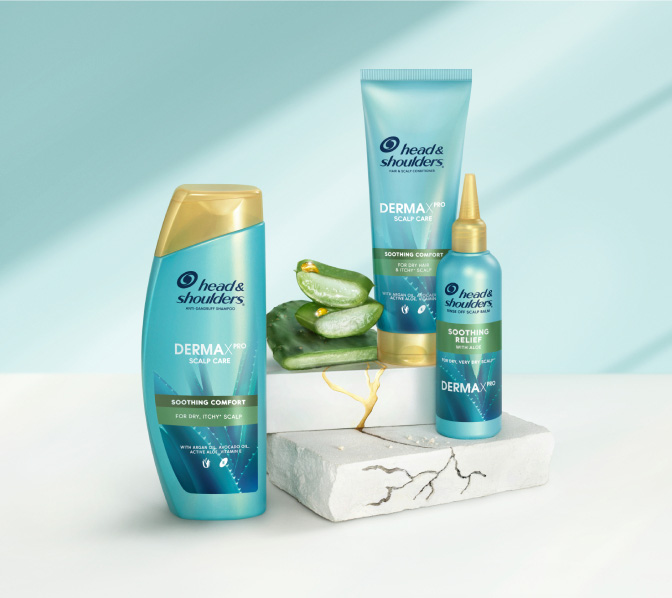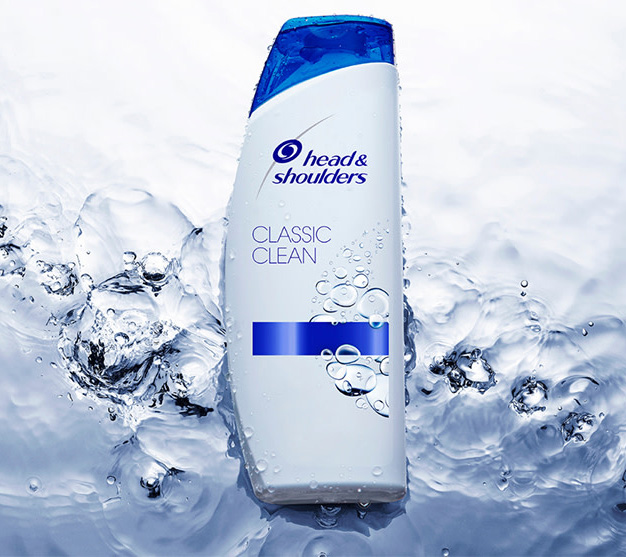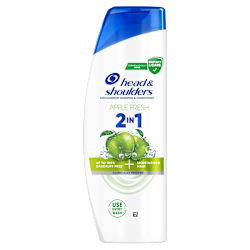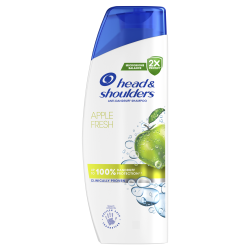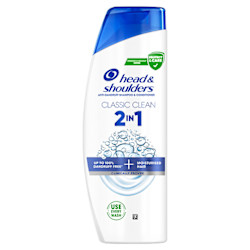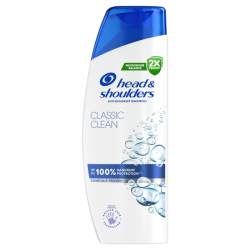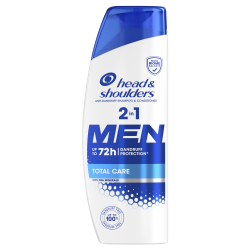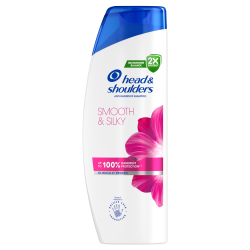Causes of dandruff: what causes dandruff?
In this article:
- Go to sectionTHE CAUSE OF DANDRUFF
- Go to sectionWHEN DOES DANDRUFF START?
- Go to sectionTHE SYMPTOMS OF DANDRUFF
- Go to sectionHOW TO GET RID OF DANDRUFF
- Go to sectionWHAT CAUSES DANDRUFF FLARE-UPS?
- Go to section5 SURPRISING CAUSES OF DANDRUFF
- Go to sectionAN OILY SCALP
- Go to sectionPOLLUTION
- Go to sectionSTRESS
- Go to sectionHEAT
- Go to sectionVITAMIN DEFICIENCY
- Go to sectionCOULD YOUR FLAKES BE SOMETHING ELSE
1 in 2 people in the world have suffered from dandruff at some point in their lives. Find out more about the cause, symptoms and the best way to get rid of dandruff.
THE CAUSE OF DANDRUFF
Dandruff is caused when 3 things come together:
A microbe that’s present on everyone’s scalp called Malassezia globosa. This microbe causes dandruff by producing substances which trigger a response in dandruff sufferers, leading to flaking.
Here’s how it worksOleic acid is produced as Malassezia globosa breaks down natural oils known as sebum on your scalp and in your hair
Your scalp can become sensitive to oleic acid – around 50% of the population are – leading to itching, dryness and redness
Your skin cells renew quicker than before, increasing their turnover rate in an attempt to ‘shed’ the substance
The excess skin cells clump on the surface of the scalp and appear as white flakes in your hair and on your scalp
This process is behind the development of all our anti-dandruff shampoos.
Not only do they clean deeply to get rid of excess oils, they also work to help tackle the root cause of dandruff to prevent it coming back.
So, use it regularly and you can help get rid of flakes as well as prevent them from coming back.
Natural oils on the scalp known as sebum.
A sensitive scalp.
As the Malassezia globosa breaks down the sebum on your scalp it produces oleic acid.
And if you’re scalp is sensitive to it – and around 50% of the world’s population is - your scalp can experience the symptoms we know as dandruff.
WHEN DOES DANDRUFF START?
Dandruff often starts with puberty as your hormones start to change, causing you to produce more scalp oils for Malassezia globosa to thrive on.
But it can also appear at other times when your hormones change such as in old age or during times of stress.
THE SYMPTOMS OF DANDRUFF
The easiest way to spot dandruff is flakes appearing on your shoulders, but there are other signs too including:
Itching
Redness
Dry scalp
These can all arise as the result of sensitivity as a sensitive scalp reacts to the dandruff-causing microbe.
HOW TO GET RID OF DANDRUFF
Luckily, treating dandruff and treating flakes, itching and dryness is easy – just use an anti-dandruff shampoo that’s been proven to work on all the symptoms of dandruff.
There’s a whole range of different shampoos depending on your symptoms, your hair type and how you want your hair to look whether it’s thicker and fuller, or smooth and silky.
They all contain an active ingredient which has been proven in hundreds of clinical trials to get rid of dandruff when used regularly.
Get advice and tips on how to get rid of dandruff
The best ones tackle:
the symptoms of dandruff – dryness, redness and flakes, to relieve scalp
the root cause – dandruff, so it doesn’t come back
WHAT CAUSES DANDRUFF FLARE-UPS?
While dandruff itself is caused by sensitivity to the oleic acid produced by a naturally occurring microbe that breaks down scalp oils, there are plenty of other factors that can make it worse.
1. HORMONAL CHANGES
Hormones control oil production, so hormonal changes may increase the amount of sebum on the scalp and therefore cause a dandruff flare-up. This is most likely to happen during puberty.
2. STRESS
High levels of stress can contribute to dandruff by causing temporary hormonal changes.
3. HAIR STYLING
Many of us use some form of hair products like gels and sprays, but build-up of certain products can aggravate the scalp and again contribute to a dandruff flare-up.
4. WEATHER
Different temperatures and weather conditions might make your hair and scalp drier, greasier or itchier, thereby aggravating a dandruff problem.
5. POLLUTION
Dirt from our surroundings clings to our hair and skin and can build up, causing discomfort on the scalp and provoking dandruff. Use Head &Shoulders Smooth and Silky Shampoo for a deep clean and long-lasting protection against dandruff.
6. WEARING A HAT
Hats can create a warm, humid microclimate around your scalp – the perfect environment for dandruff-causing microbes to thrive! Protect your hair and scalp by using Head & Shoulders Classic Clean 2-in-1 every time you wash your hair.
7. CHANGING YOUR SHAMPOO
There’s no cure for dandruff, so if you stop using your anti-dandruff shampoo, the symptoms will return. Keep using Head & Shoulders and your head will stay up to 100% flake free!*
While these things don’t cause dandruff, they can make it appear worse. So, use Head & Shoulders every time you wash your hair for beautiful, up to 100% flake free* hair.
5 SURPRISING CAUSES OF DANDRUFF
The key to ditching dandruff is dealing with its main causes – but how much do you really know about the common condition that leads to flakes in your hair? Less than you realise, perhaps…
Dandruff is one of the biggest scalp and hair issues around, but just because it's common doesn’t mean it’s always completely understood.
Below scalp expert Kelly Morell looks at some of the more unexpected reasons behind what causes dandruff, and offers her advice for stopping it in its tracks.
AN OILY SCALP
It seems obvious that dryness can lead to flakes – so how can a greasy scalp do the same?
Because grease is often due to an overproduction of oil (or sebum) in the hair follicles, and excess oil is prone to clumping and falling off in flakes.
Finding a cleansing schedule that works for your hair type is important for fending off flakes.
POLLUTION
City dwellers, this one’s for you. Chemicals in the air can wreak havoc with the skin on your scalp, leading to sensitivity and flakes.
Outside of investing in a sprawling country estate to escape to, one of the best ways to fight the impact of pollution on your hair is with a targeted product that has been formulated to protect and soothe your scalp specifically – like Head & Shoulders range.
Its formula shields against oxidative stressors like the environment, to protect and relieve the scalp from both the early and invisible signs of dandruff to stop it before it even starts.
STRESS
Stress affects everything from your sleep to your patience levels – but did you know it takes a toll on your scalp, too?
While stress doesn't actually cause dandruff, it can seriously aggravate it. By weakening your immune system’s ability to regulate the naturally occurring microbes that live on your scalp, stress can lead to dryness, flakes and itchiness.
Managing your stressors is essential for the health of your scalp.
HEAT
Whether it’s regular blow-drying or a daily date with your curling tongs, too much heat can dry out your scalp and leave a mark in the form of flakes.
Embracing the natural dry look at least a couple of days a week will give your scalp a chance to recover and reduce overall discomfort.
VITAMIN DEFICIENCY
Zinc, B vitamins and fats all play a crucial role in the health of your scalp, so be sure to fill your plate with a variety of fruits, vegetables and lean meats like fish and poultry to keep your hair and scalp happy and up to 100% flake free*.
Unique causes aren’t the only surprising thing about dandruff – here Kelly discusses some of the more unexpected signs you have the condition.
COULD YOUR FLAKES BE SOMETHING ELSE
Flakes are the most visible sign of dandruff – but they may also be a sign of something else.
For example Seborrheic Dermatitis has almost identical symptoms like flaking, dryness and itching.
It does tend to be more severe and can affect parts of the body other than the scalp so that’s a good way to check.
Scalp Psoriasis too is easily confused with dandruff. However, there are some key differences here too such as flakes that appear more silvery and scaly, a greater severity, and skin redness which may extend beyond the hairline.
A convenient way to see if dandruff treatment helps your condition is to use Head & Shoulders exclusively for 3 weeks, making sure you shampoo at least 3 times per week.
If it’s dandruff, you should see your symptoms improve. If they don’t, contact your doctor or dermatologist who’ll help you identify the right cause and treatment.
For lasting dandruff control and prevention, use Head & Shoulders shampoo regularly.
*Visible flakes, regular use.

